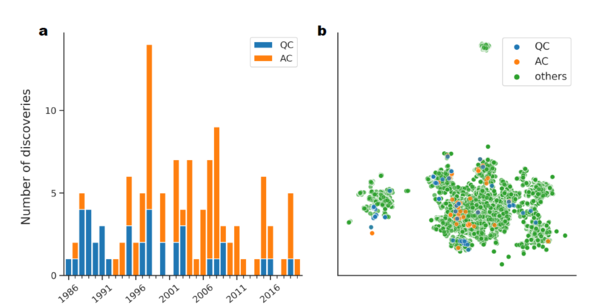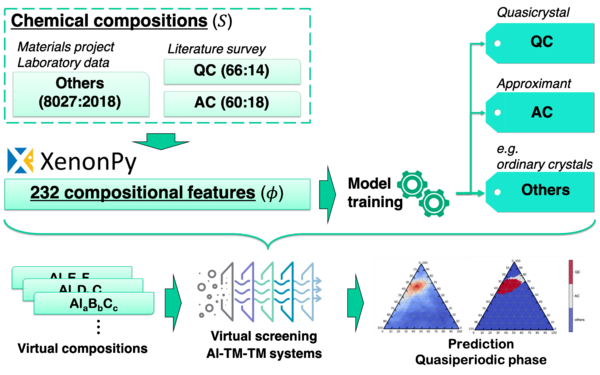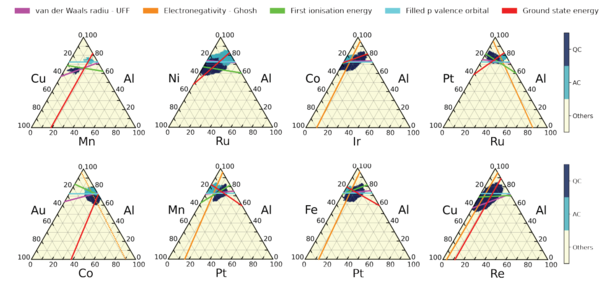Machine Learning to Predict New Quasicrystals First step toward understanding the stabilization mechanism of quasicrystals
Machine Learning to Predict New Quasicrystals First step toward understanding the stabilization mechanism of quasicrystals
July 20, 2021
Outline
Quasicrystals have emerged as the third class of solid-state materials, distinguished from periodic crystals and amorphous solids, that have long-range order without periodicity exhibiting rotational symmetries disallowed for periodic crystals in most cases. The first quasicrystal was discovered by Shechtman in 1984. Over the next 35 years, more than 100 types of quasicrystals were found, and quasicrystals were recognized as the third class of solid states along with ordinary crystals and amorphous. However, the pace of the discovery has slowed significantly in recent years.
A joint research group of the Institute of Statistical Mathematics, the University of Tokyo, and Tokyo University of Science has demonstrated that machine learning algorithms can be used to learn the compositional patterns of quasicrystals found so far and predict the chemical composition of new quasicrystals. Furthermore, by extracting the input- output rules inherent in the black box model of machine learning, they were able to uncover the laws of quasicrystal phase formation. These laws can be expressed in five simple equations. These may serve as design guidelines for material searches, which have been long sought in quasicrystal research.
1. Background
Quasicrystals do not have the translational symmetry of ordinary crystals but have a high degree of order in their atomic arrangement. The first quasicrystal was discovered in 1984 by Israeli metallurgist Dr. Daniel Shechtman (Nobel Laureate in Chemistry in 2011). Since then, about 100 stable quasicrystals have been found so far. In the history of quasicrystal research, the discovery of new quasicrystals has led to the discovery of new physical phenomena such as anomalous electronic properties, insulating behavior, valence fluctuations, quantum criticality, and superconductivity. However, in recent years, the pace of discovery of new quasicrystals has slowed down significantly (Fig. 1). This trend is mainly due to the lack of clear design guidelines for the synthesis of new stable quasicrystals.

Figure 1. Stable quasicrystals (QC) and approximants (AC) that have been discovered so far. a. Annual trend in the discovery of new thermodynamically stable quasicrystals (blue) and approximant crystals (orange) in aluminum alloys. b. Distribution of the compositional dataset that was visualized onto a two-dimensional space.
2. Prediction of chemical compositions to form quasicrystals
We tackled the problem of predicting quasicrystals using a simple workflow of supervised learning (Fig. 2). The input variable of the model is the chemical composition. The output variables represent class labels indicating “quasicrystals”, “approximant crystals”, and “others” including ordinary periodic crystals. As training data, we used the chemical compositions of quasicrystals, approximants, and ordinary crystals that have been discovered so far. For the data analysis, we introduced XenonPy (*2), an open-source software developed by the group at the Institute of Statistical Mathematics. We evaluated the predictability of machine learning models for the three-class classification task. The predicted quasicrystalline phases were compared with known experimental phase diagrams, and the prediction accuracy reached nearly 0.714. In particular, the phases of ordinary periodic crystals were identified to be almost perfectly predictable. We aim to use this model to narrow down the candidate compositions that form quasicrystals and approximants.

Figure 2. Machine learning workflow. A model was created using a random forest classifier that predicts the class label of a given chemical composition as quasicrystal (QC), approximant (AC), or “others”. Model training and testing were performed on the compositional features of 80 known quasicrystals, 78 approximants, and 10,090 ordinary crystals. We then performed high-throughput screening across all Al-TM-TM (TM: transition metal) alloys to generate their predicted phase diagrams.
3. Rediscovery of Hume-Rothery's law by machine learning
Here, the research group noticed one interesting fact. It turns out that the machine learning model learns an empirical rule for the formation of quasicrystalline alloys called the Hume-Rothery’s electron concentration law. Most quasicrystals and approximants are known to be stabilized in compositions where the average number of itinerant electrons per atom, denoted by e/a, takes on a specific value. In aluminum alloys, stable quasicrystals and approximants tend to appear in the composition that satisfies e/a = 1.8. As shown in Fig. 3, the regions of quasicrystals and approximant crystals predicted by machine learning overlap with the straight line of e/a = 1.8 for most aluminum alloys. This means that the machine learning algorithm has rediscovered this widely known rule of thumb from only the composition list of quasicrystal and approximant crystals that have been found so far.

Figure 3. Comparison between predicted and experimental phase diagrams of ternary aluminum alloys. Dark blue represents quasicrystalline phases and light blue represents approximant crystals. Orange represents a straight line satisfying Hume-Rothery’s electron concentration law, e/a=1.8.
4. Rules for quasicrystal formation discovered by machine learning
Furthermore, by extracting the input-output rules inherent in the black-box model of machine learning, we have uncovered rule-of-thumbs on the formation of quasicrystalline phases. These rules are expressed in five equations for the average van der Waals radius and electronegativity of constituent elements (Fig. 4). These conditions provide design guidelines for the search for new quasicrystals. There would be many other rules hidden in the model. By exhaustively examining the rule sets in the trained machine learning, we will elucidate the formation mechanism of quasicrystals, which is a central issue in solid state physics.

Figure 4. Five rules for the formation of QC/AC phases that were discovered by machine learning. The rules are represented by straight lines on the predicted phase diagrams of the eight systems.
5. Towards discovery of innovative quasicrystals
With this achievement, we have taken the first step toward realizing quasicrystal discovery through data science. Using this predictive model, many researchers are now working on the synthesis of new quasicrystals. In particular, we aim to discover highly innovative quasicrystals, such as semiconductor quasicrystals, superconducting quasicrystals, and ferromagnetic quasicrystals. During nearly 35 years after the discovery of the first quasicrystal, only little is known about the formation mechanism of quasicrystals. Data science may make a significant contribution to solving this unsolved issue in quasicrystal research.
Publication
Title: Machine learning to predict quasicrystals from chemical compositions
Authors: Chang Liu1, Erina Fujita2, Yukari Katsura2, Yuki Inada2, Asuka Ishikawa3, Ryuji Tamura3, Kaoru Kimura2, Ryo Yoshida1,4,5
Journal: Advanced Materials
DOI: 10.1002/adma.202102507
Publication date:2021/07/19
Affiliations
- The Institute of Statistical Mathematics, Research Organization of Information and Systems
- The University of Tokyo, Graduate School of Frontier Sciences, Department of Advanced Materials Science
- Tokyo University of Science, Department of Materials Science and Technology
- Graduate University for Advanced Studies, Department of Statistical Science
- Research and Services Division of Materials Data and Integrated System (MaDIS), National Institute for Materials Science (NIMS)
Acknowledgements
This work was supported in part by a MEXT KAKENHI Grant-in-Aid for Scientific Research on Innovative Areas (Grant Number 19H05820)


